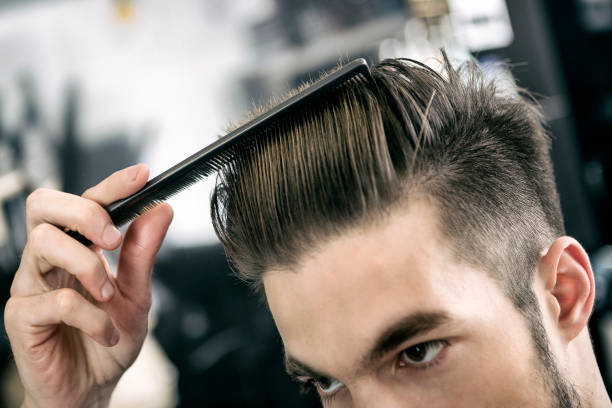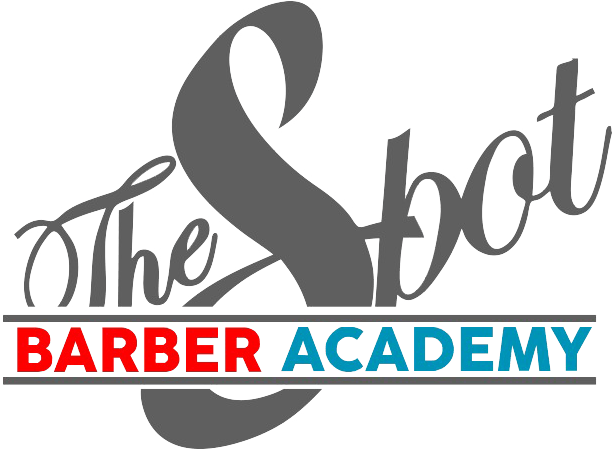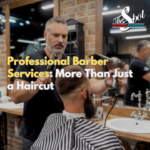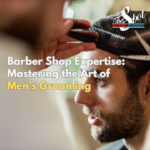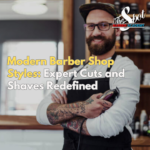Barber Shop Styles Introduction
The world of men’s grooming is constantly evolving, with barber shop styles at the forefront of this exciting transformation. In this comprehensive guide, we’ll delve into the latest trends that are defining men’s haircuts in contemporary barber shops. Whether you’re a style enthusiast or a professional barber, understanding these trends is key to staying ahead in the dynamic world of men’s grooming.
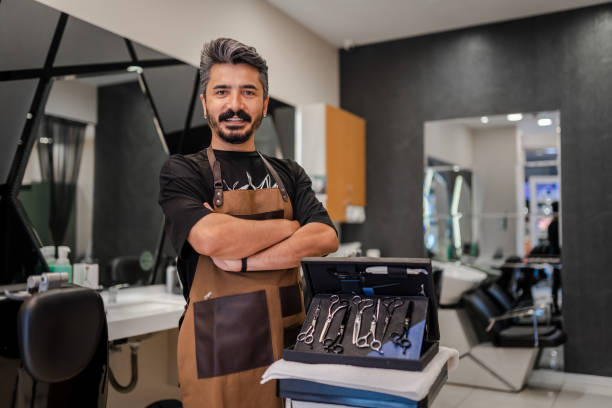
Training and Education in Barbering
The Role of Barber Schools
- Structured Curriculum: Barber schools provide a structured curriculum that covers all facets of barbering. This includes hair cutting techniques, styling, shaving, and even business management skills.
- Hands-On Experience: These schools offer practical, hands-on training. Students get to practice on real clients under the supervision of experienced instructors.
The Importance of Mentorship
- Learning from Experts: Mentorship from seasoned barbers is invaluable. It offers insights into real-world barbering beyond what is taught in textbooks.
- Career Guidance: Mentors can also provide career guidance, helping new barbers navigate the early stages of their professional journey.
Incorporating Business Skills
- Entrepreneurial Training: Understanding the business side of barbering is essential. This includes learning about shop management, customer service, and marketing.
- Financial Management: Barbering courses increasingly include elements of financial management, helping barbers to become successful entrepreneurs.
Emphasis on Health and Safety
- Hygiene Practices: Training programs emphasize the importance of hygiene and sanitation in barber shops to ensure the safety and health of clients.
- Safe Use of Tools: Proper training in the safe use of barbering tools and equipment is also a critical part of the education.
The Benefit of Apprenticeships
- Real-World Experience: Apprenticeships provide an opportunity to work in a real barber shop environment. This experience is crucial for building confidence and expertise.
- Networking Opportunities: Working alongside experienced barbers offers networking opportunities, which can be vital for career advancement.
Staying Abreast of Trends and Techniques
- Continual Learning: The world of barbering is constantly evolving. Regularly attending workshops and industry events keeps barbers up-to-date with the latest styles and techniques.
- Adapting to Change: Flexibility and willingness to learn new trends are essential traits for modern barbers.
The Importance of Skill and Craftsmanship
In the realm of Barber Shop Styles, skill and craftsmanship are paramount. They are the foundation of every great haircut and the essence of the barbering art. This section delves into why these elements are crucial in the industry.
Mastery of Techniques
- Precision Cutting: Skill in barbering starts with precision. It’s about mastering various cutting techniques to achieve flawless results.
- Styling Expertise: Beyond cutting, styling expertise is essential. It’s the ability to shape and style hair to suit individual preferences and trends.
Artistic Flair
- Creativity: Craftsmanship in barbering is also about creativity. It involves envisioning and executing unique styles that stand out.
- Personal Touch: A barber’s artistic flair adds a personal touch to each haircut. This makes every visit to the barber shop a unique experience.
Understanding of Hair and Scalp Health
- Healthy Practices: Skilled barbers understand the importance of maintaining hair and scalp health. They use techniques and products that promote healthy hair growth.
- Customized Advice: They also provide personalized advice on hair care. This includes recommendations on products and routines best suited for individual hair types.
Continuous Learning and Adaptation
- Keeping Up-to-Date: The barbering industry is ever-evolving. Staying updated with the latest trends and techniques is vital for continued excellence.
- Adapting to Change: Adaptability is key. Barbers must be able to integrate new trends and technologies into their craft.
Sustainable and Ethical Grooming Practices
Sustainable and ethical grooming practices in Barber Shop Styles are increasingly becoming a priority in the barbering industry. These practices not only benefit the environment but also cater to the growing consumer demand for eco-friendly options. Let’s explore the key aspects of this important trend.
Embracing Eco-Friendly Products
- Natural Ingredients: Many barbershops are shifting to products with natural, organic ingredients. These products are kinder to the environment and gentler on the skin.
- Reducing Chemical Use: Limiting the use of harsh chemicals is also a focus. It’s about promoting healthier hair and a safer environment.
Minimizing Waste
- Recycling Initiatives: Barber shops are implementing recycling programs. This includes recycling hair, product containers, and other materials.
- Reducing Single-Use Items: Efforts are also being made to reduce the reliance on single-use items. Reusable and biodegradable options are preferred.
Ethical Business Practices
- Fair Trade Products: Ethical grooming extends to using fair trade products. This ensures that the products are sourced responsibly.
- Supporting Local Communities: Many barber shops support local suppliers. This not only reduces carbon footprint but also boosts the local economy.
Educating Clients
- Awareness Campaigns: Barber shops are educating clients about sustainable practices. This includes recommending eco-friendly hair care routines.
- Promoting Sustainable Choices: Barbers are becoming advocates for sustainable lifestyles. They encourage clients to choose products and practices that align with these values.
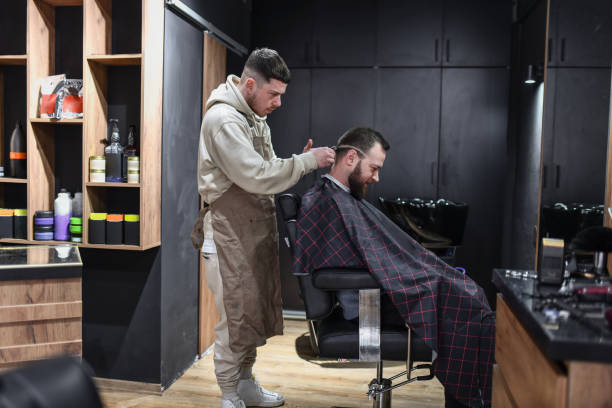
The Rise of Personalization
In the world of barbering, personalization has become a defining trend. It’s about crafting haircuts that fit individual styles and preferences. Let’s dive into the various facets of this personalized approach in modern barbering.
Tailoring to Individual Needs
- Unique Styles: Every individual has unique hair and style preferences. Barbers are now focusing on creating haircuts that cater to these individual needs.
- Consultation is Key: The process often begins with a thorough consultation. Here, barbers discuss preferences, lifestyle, and hair type with clients.
Influence of Face Shape and Hair Type
- Face Shape Consideration: Personalized haircuts take into account the client’s face shape. The aim is to enhance their natural features.
- Adapting to Hair Type: Different hair types require different approaches. Barbers tailor their techniques to suit fine, thick, curly, or straight hair.
Keeping Up with Personal Trends
- Staying Current: Personalization means staying updated with the latest individual trends. It’s about being versatile and adaptable.
- Client’s Lifestyle: Understanding a client’s lifestyle is crucial. This insight allows barbers to create styles that are not only fashionable but also practical.
The Role of Technology
- Digital Tools: Technology aids in personalization. Digital portfolios, for instance, help clients convey their desired looks more effectively.
- Ongoing Communication: Technology also facilitates ongoing communication. This ensures that the haircut evolves with the client’s changing preferences.
The Resurgence of Classic Cuts
In the ever-evolving world of men’s grooming, classic cuts are making a remarkable comeback. This resurgence highlights the timeless appeal of these styles. We’ll explore various aspects of these enduring trends.
Embracing the Timeless Elegance
- Simplicity and Sophistication: Classic cuts are synonymous with simplicity. They offer a clean, sophisticated look that never goes out of style.
- Versatility: These cuts suit various face shapes and hair types. This versatility makes them a popular choice for men across ages and lifestyles.
Key Classic Styles
- The Pompadour: Characterized by its voluminous top and sleek sides, the pompadour exudes classic charm.
- The Crew Cut: A low-maintenance style known for its short length and crisp edges. It’s ideal for a neat, no-fuss look.
- The Side Part: A polished style that works well in formal and casual settings. It’s distinguished by a sharp side parting.
Modern Twists on Classic Themes
- Textured Layers: Adding texture to a classic cut creates a modern edge. It allows for more styling flexibility.
- Tapered Sides: Modern barbering often incorporates tapered sides into classic styles. This technique adds a contemporary touch to traditional looks.
Why Classic Cuts Remain Popular
- Timeless Appeal: These styles have stood the test of time. Their enduring appeal lies in their ability to blend tradition with modern tastes.
- Professional Look: Classic cuts are often associated with professionalism. They are perfect for the workplace yet stylish enough for social settings.

The Role of Technology in Barbering
Revolutionizing Client Experience
- Online Appointment Systems: These systems have simplified the booking process, allowing clients to schedule and manage their appointments with ease.
- Virtual Queue Management: Some barber shops utilize virtual queue systems. This technology reduces wait times and enhances the customer experience.
Advancements in Hair Styling Tools
- Innovative Cutting Tools: The development of advanced hair clippers and razors offers precision and versatility in haircuts.
- Heat Styling Technology: Modern heat styling tools with adjustable settings provide more control and reduce hair damage.
Enhancing Learning and Training
- Online Education Platforms: Aspiring barbers now have access to online tutorials and courses. This facilitates learning from anywhere at any time.
- Virtual Reality (VR) Training: Some institutions use VR for barber training, offering a realistic and interactive learning environment.
Social Media and Brand Building
- Digital Portfolio: Barbers showcase their work on platforms like Instagram and Facebook. This serves as a digital portfolio for attracting clients.
- Social Media Engagement: Engaging with clients on social media helps build a community around the barber shop’s brand.
Streamlining Operations and Management
- Inventory Management Systems: These systems help in tracking products and supplies, optimizing stock levels, and reducing waste.
- Digital Payment Solutions: The integration of digital payment methods offers convenience for clients and efficient transactions for businesses.
Personalization through Data
- Client Preference Tracking: Technology enables the recording of client preferences and history. This leads to more personalized service in subsequent visits.
- Feedback and Analysis: Digital feedback tools allow for the collection and analysis of client feedback, enabling continuous improvement.
Barber Shop Styles Conclusion: Elevate Your Barbering Skills at The Spot Barber Academy
In conclusion, staying abreast of the latest barber shop styles is key to thriving in the dynamic world of men’s grooming. If you’re passionate about barbering and keen to master these trends, consider joining our Barbering program at The Spot Barber Academy. Our comprehensive training will equip you with the skills, knowledge, and confidence to excel in this exciting industry. Embrace the opportunity to transform your passion into a profession with us.
